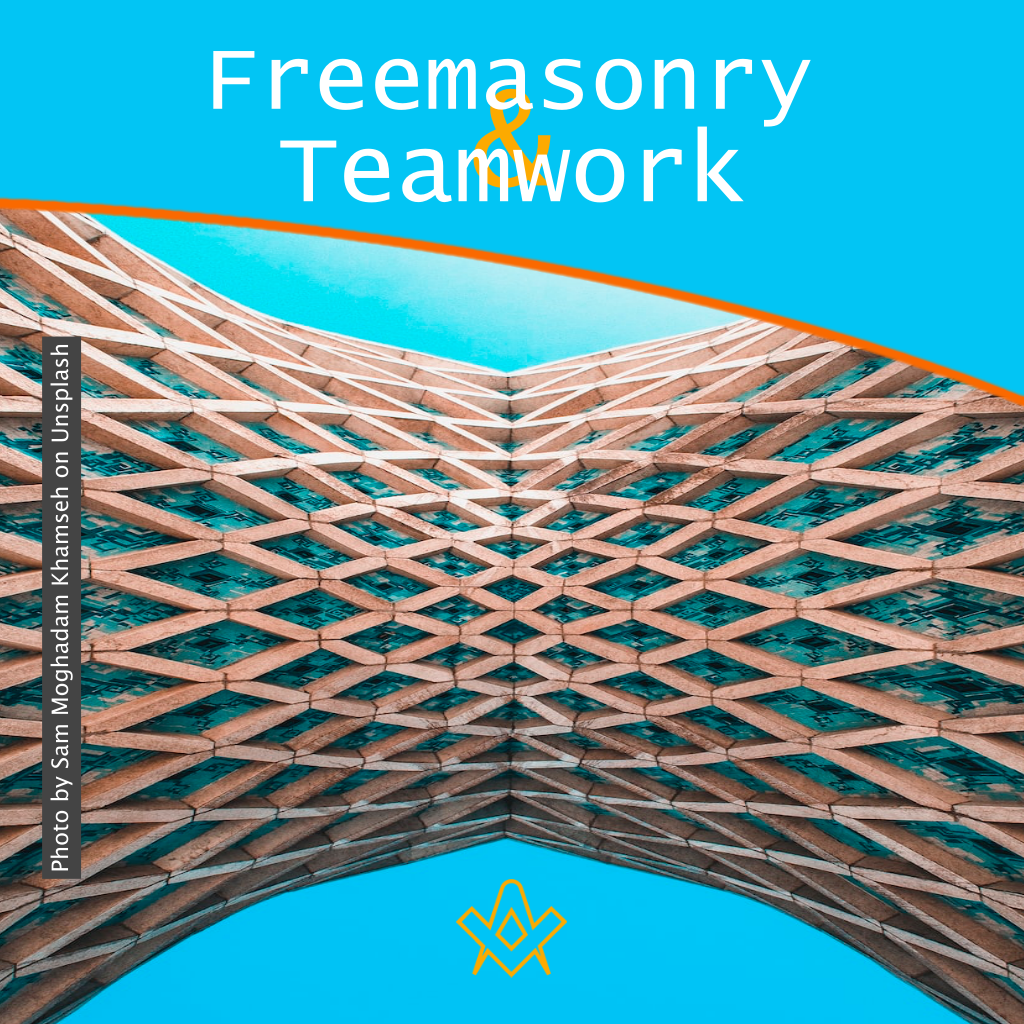A concept that is both based on our Freemasonic rituals and what we understand as teamwork.
My first thought of teamwork is being part of a soccer or football team and having a position on the field of play and a role to play in that position.
As a defender, the role is to defend the goal, get the ball, and pass it to a forward.
As a forward, it is to get the ball and kick it past the goaltender into the goal.
Every member of the team works toward the same end—to score goals against the opposing team.
Freemasonry and teamwork
Masonic ritual is comprised of, essentially, three one-act plays, and one four-act play of installation and investiture.
A large part of the ritual is derived from the Volume of the Sacred Law, the Holy Bible. In a discussion of Freemasonry and teamwork, it is useful to provide both a definition of teamwork, and, as well provide some aspects from the Volume of the Sacred Law that are relevant to the discussion.
What is teamwork?
Teamwork has been defined by some as “The process of working collaboratively with a group of people in order to achieve a goal.
Teamwork is often a crucial part of a business, as it is often necessary for colleagues to work well together, trying their best in any circumstance.
Teamwork means that people will try to cooperate, using their individual skills and providing constructive feedback, despite any personal conflict between individuals.”
Jachin and Boaz
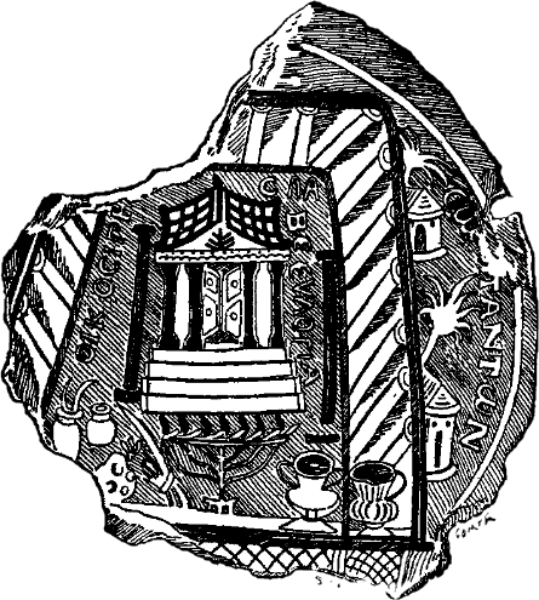
An illustration from the Encyclopaedia Biblica (1903) of a 3rd century glass bowl depicting Solomon’s Temple with the two pillars, Boaz and Jachin at the entrance steps.
IMAGE LINKED: wikimedia Attribution 4.0 International (CC BY 4.0)
Exodus 13, 21:
And the Lord went before them by day in a pillar of cloud, to lead them the way; and by night in a pillar of fire, to give them light; to go by day and night:
I Kings 7, 13-22:
And king Solomon sent and fetched Hiram out of Tyre.
He was a widow’s son of the tribe of Naphtali, and his father was a man of Tyre, a worker in brass: and he was filled with wisdom, and understanding, and cunning to work all works in brass. And he came to king Solomon, and wrought all his work.
For he cast two pillars of brass, of eighteen cubits high apiece: and a line of twelve cubits did compass either of them about.
And he made two chapiters of molten brass, to set upon the tops of the pillars: the height of the one chapiter was five cubits, and the height of the other chapiter was five cubits:
And nets of checker work, and wreaths of chain work, for the chapiters which were upon the top of the pillars; seven for the one chapiter, and seven for the other chapiter.
And he made the pillars, and two rows round about upon the one network, to cover the chapiters that were upon the top, with pomegranates: and so did he for the other chapiter.
And the chapiters that were upon the top of the pillars were of lily work in the porch, four cubits.
And the chapiters upon the two pillars had pomegranates also above, over against the belly which was by the network: and the pomegranates were two hundred in rows round about upon the other chapiter.
And he set up the pillars in the porch of the temple: and he set up the right pillar, and called the name thereof Jachin: and he set up the left pillar, and called the name thereof Boaz.
And upon the top of the pillars was lily work: so was the work of the pillars finished.
We first meet Jachin and Boaz in the biblical book of Exodus that tells of when the Lord guided the Children of Israel out of Egypt.
We again find them in the first book of Kings when King Solomon had Hiram of Tyre cast the pillars and place them at the entrance of the Temple.
The chapiters were, no doubt, used to hold oil to replicate the fire and cloud of the pillars seen during the exodus.
In this way, there would be fire by burning oil, and cloud by burning oil with green vegetation above, both in memory of the pillars referred to in the Book of Exodus.
The pillars Jachin and Boaz were never actually physically conjoined in biblical text; however, they were conjoined in a symbolic sense in that they worked together as leading lights for the Children of Israel, and also as a reminder to the Israelites of their struggle to find freedom.
To Masons, they serve as a reminder that working together we increase our strength; and as a strong, united team, all things are possible—even freedom and a stable society.
While the pillars Jachin and Boaz were never physically conjoined, the principle of strengthening gateways, doorways, and widows is achieved in a building either by the use of a lintel and columns, Roman arches, or Norman arches that join the two pillars together.
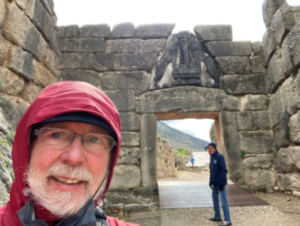
Chris E. Batty, a selfie on a rainy day at the Lyon Gate, 2022 03 23
Seen in the photograph, one of the earliest gateways to demonstrate that principle is the Lyon Gate at Mycenae in Greece, built about 2000 BCE.
![]()
Let us remember, then,
In strength,
God will establish,
Stability
Network
We also understand that the chapiters of the pillars Jachin and Boaz contained network, and network is a symbol of teamwork. Each and every knot in a network is necessary for the network to work efficiently.
It does not matter whether the network is a fishermen’s net or a mosquito net, each knot is necessary for that network to function efficiently, with each knot being part of a team of knots.
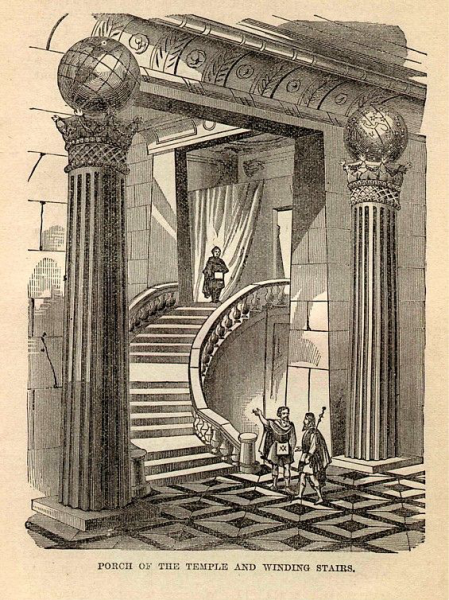
Illustrating the ‘network’ around the top of the two pillars
IMAGE LINKED: wikimedia Attribution 4.0 International (CC BY 4.0)
The very last lecture to the Candidate
The very last lecture to the Candidate is made every year in the presence of the entire lodge. However, few realize that it is the very last lecture made to the Candidate.
The Candidate in a private lodge has been initiated, passed, raised, worked as a Steward of the lodge, worked as a Deacon, worked as a Warden, and finally has worked as Master of the lodge.
Along his journey though the various positions or offices in the lodge, he receives instruction as to his duties in that position or office.
Early in his journey, the instruction is very detailed; but as the Candidate progresses, the details and instruction change depending on the position or office that Candidate is about to undertake.
The very last lecture is given by the Worshipful Master to the Immediate Past Master of the lodge.
It is this lecture, the 47th Problem of the First Book of Euclid, that signifies the end of a Mason’s journey through his lodge.
While it is acknowledged that many Past Masters go back to undertake a position that is vacant or that they for some reason skipped on their initial journey, their path is complete with this lecture.
Revisiting various offices helps one to understand and obtain a clearer picture of the whole system, and there is always a lot to learn.
The actual body of the lecture is a continuation of the message of teamwork, of the two great pillars, and of network.
As the figure in this jewel depends upon its several lines, angles and triangles, which forms the whole, so Masonry depends upon its several members and fundamental principles upon which the institution is founded.
Every member of the lodge from the EA to the Past Masters is an important member of a Masonic team, and each must work together with the whole team for the lodge to be a successful and enduring lodge. This fact also applies to any business, sports team, or any other organization.
Euclid’s proof
Euclid’s proof is rather complicated but can be found at the following link: Pythagorean theorem
The proof contains the following geometric figure, which is the Past Master’s Jewel in both English and Alberta Craft lodges.

The lines, angles, and triangles of the jewel are required for Euclid’s proof and as indicated in the lecture each line, angle, and triangle is a representation of the importance of every member of the Lodge and the fundamental principles of Freemasonry for the lodge to be successful and enduring.
The presentation to the Immediate Past Master by the Worshipful Master of the lodge is the very last lecture presented to the Candidate as a reminder to him that every member of the lodge is equally important, and that no one should consider himself to be entitled to special privileges—even as a Past Master.
Article by: Chris E. Batty
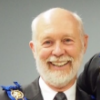
Chris E. Batty was born in the spring of 1945 in Tunbridge Wells, Kent, UK.
He immigrated to Canada early in 1965 with just $45 in his pocket and very little education.
Chris’s interest in Freemasonry stems from his father, who was a member of Bostall Heath Lodge No. 4492, English Constitution.
He has been a Freemason since 1975, served as Worshipful Master of Saskatchewan Lodge No. 92 GRA for the Masonic Year 1982; appointed the Grand Pursivant for the Masonic Year 2001 – 2002; elected as the District Deputy Grand Master for the Northern Lights District for the year 2005 – 2006.
Elected to the Masonic Higher Education Bursary Committee in 2006 and served as the Chairman from 2007 to 2014.
Elected Junior Grand Warden in 2012, and served as SGW, DGM, and the Grand Master for the year 2015 – 2016.
He was appointed as an Honorary Past Grand Master of the Grand Lodge of Saskatchewan in 2015.
And subsequently, an Honorary Grand Master of the Grand Lodge of Manitoba in 2017.
Recent Articles: by Chris Batty
 The Alberta Masonic Higher Education Bursary Fund is to help the next generation of Albertans, our children and grandchildren, to obtain the education they need to lead successful lives and contribute to the welfare of mankind. As you can see from this little lesson of our history, education is truly a Masonic obligation. |
 What is leadership and who does freemasonry help develop those skills needed to be a better leader |
 Value Proposition of Freemasonry In addressing declining lodge membership and lack of attendance, we need to assess the value it offers to members. What is value, and what does it mean to you? |
 The Cable Tow: Its Origins, Symbolism, & Significance for Freemasons - Unbinding the significance of the cable tow. |
masonic knowledge
to be a better citizen of the world
share the square with two brothers

click image to open email app on mobile device



